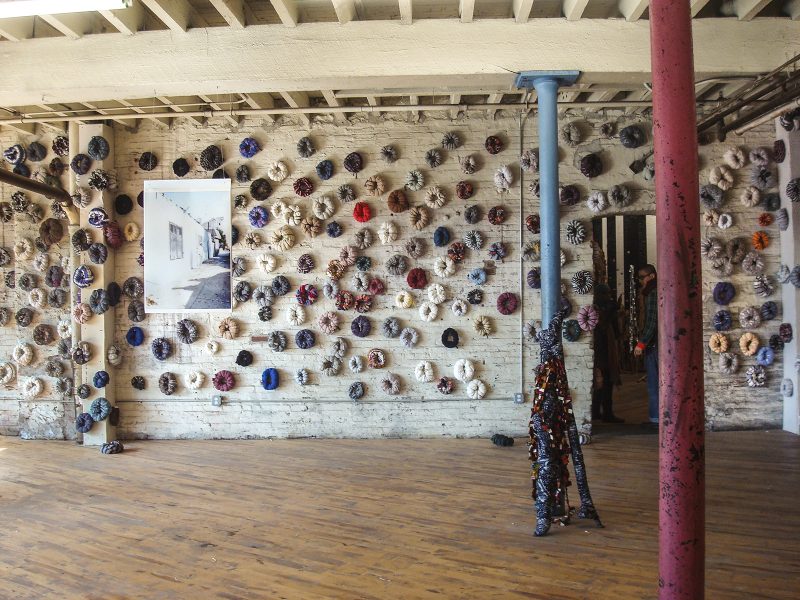
Art made of “trash” is a concept that has both political and social meaning in Material Memory. As the product of Olanrewaju (Lanre) Tejuoso’s time at the Village of Arts and Humanities’ SPACES residency, Material Memory represents several firsts for the organization. It is first time a SPACES artist’s residency has aimed to provide an intangible (rather than concrete) social impact, and the first one that has resulted in an exhibition.
The exhibition brings some complicated, important questions to the forefront for the Village to consider in the future–what is the balance between art and social work? How does the creation of art for art’s sake fit in with the socially engaged goals of the organization? Is it an issue of ethics? Lilian Dunn, the SPACES program manager, considered that although an exhibition is unusual for the Village, there is certainly value in a parent bringing their children to see art, or bringing neighborhood residents an experience they might not have otherwise.
Remembrance, memorial, and trauma
Around 20 people collaborated to make it happen, including the studio team, community outreach team, and neighborhood residents who joined at various points along the way. All the work is based on the ideas of remembrance, memorial, and trauma–and informed by the unique way of memorializing that Lanre observed when he first came to Philly. Lanre is known for his work using litter and recyclables as the primary material on a grand scale, making statements on environmental issues and the politics of labor.
It began one day when Lanre, out searching for materials to use early on in his residency, noticed a ceramic mug with a candle in it on the side of the road. That sparked his interest, not understanding why someone would toss away such a nice object. This was how he came upon the culture of street memorial in Philly, placing objects outside to tell the story of their lost loved ones and commemorate them. Learning more about the ways that we memorialize–such as arranging objects in a meaningful way using bright colors, flowers, things from those that have died, and writing–informed his choices for materials as he strove to create the same kind of statement as the memorials that he saw.
Material challenges
A major challenge in the creation of Lanre’s work was the availability of materials; limited access to trash dumps and efforts at recycling in America severely stunted the scale of his projects during his residency. Because of the differences in laws surrounding trash in the U.S. (incentivized recycling in America allows people to make a profit off of bottle collection) versus his home country of Nigeria, the sheer volume of recyclables and litter available for the taking was much less here than what he was used to at home. Out of necessity, the Village began to look for alternative secondhand items and found a wealth of fabric being tossed. This unexpected source of material set off a series of work revolving around textiles, and led to some of the most conceptually striking installations in the show. Lanre sees the work he produced for this show as concept “sketches” for larger installations he hopes to produce once he has access to more space, assistance, and material.
One of the primary objectives of the project was to develop personal connections with the team, community members, and studio assistants he worked with. Lanre expressed interest in giving new life to both the materials and the people, wanting to be around people who were looking to transform their lives in some way. In general, he claims to gravitate towards working with inmates, people in asylums, or generally anyone struggling in their lives. Lanre wants to get such people involved because of the therapeutic benefits of bonding as part of a group and doing somewhat repetitive tasks, as well as capitalizing on the chance to help out by paying them. People don’t necessarily realize it at the time, but he is aiming to help them achieve a sense of self-confidence and independence.
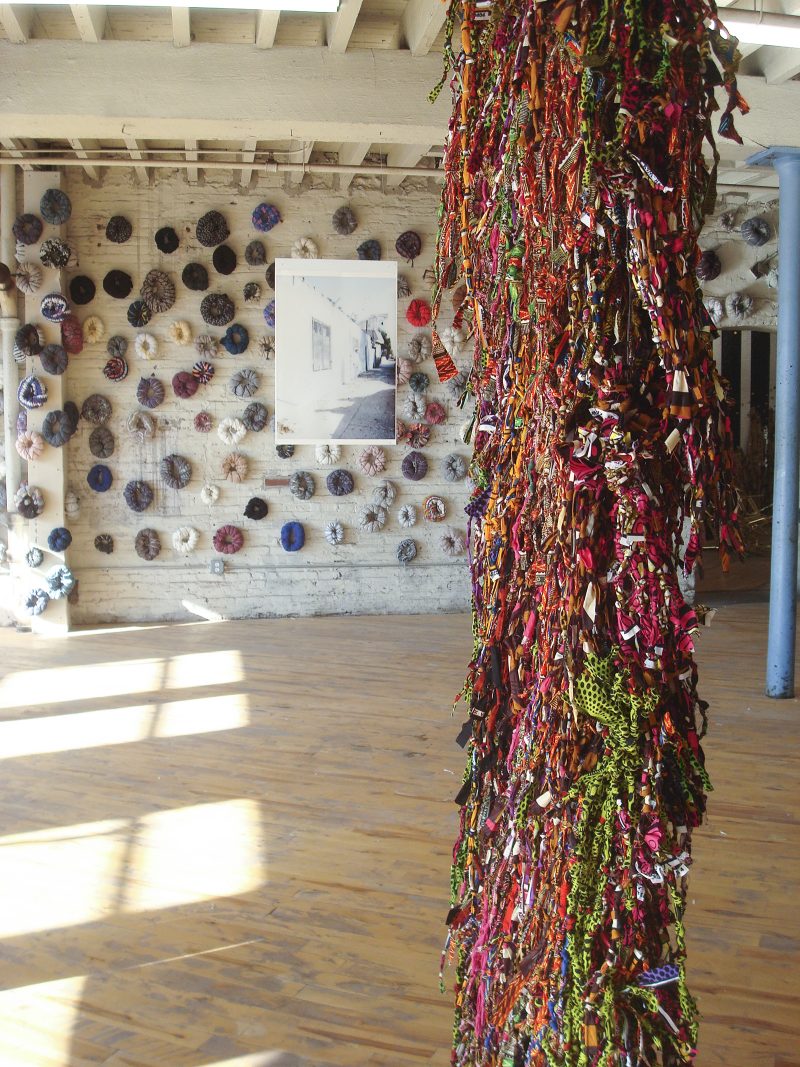
Memory Knots (Remember)
As anyone who knits or crochets knows, repetitive activities can be a meditative experience; simple, seemingly mindless tasks have a way of comforting and facilitating open dialogue.
When Lanre’s assistants noticed he frequently used knotting techniques in his work, it became a starting point for community engagement; assistants went outside knotting fabric and drew in people to come collaborate. In the studio people came together, hanging out and talking while knotting. Building up trust between Lanre and the team was integral to creating the work; the physical activity of knotting was a means of getting the participants to open up about their losses of loved ones.
The knotting exercises completed two cascading columns of fabric, with interspersed notes from contributors–some playful, but mostly solemn. One of the team members who lost his brother violently took the initiative to lead a project photographing his brother’s favorite places. Stemming from a discussion of ways they deal with grief, another contributor said he goes to Wissahickon Park–the team went there as well and took photos.
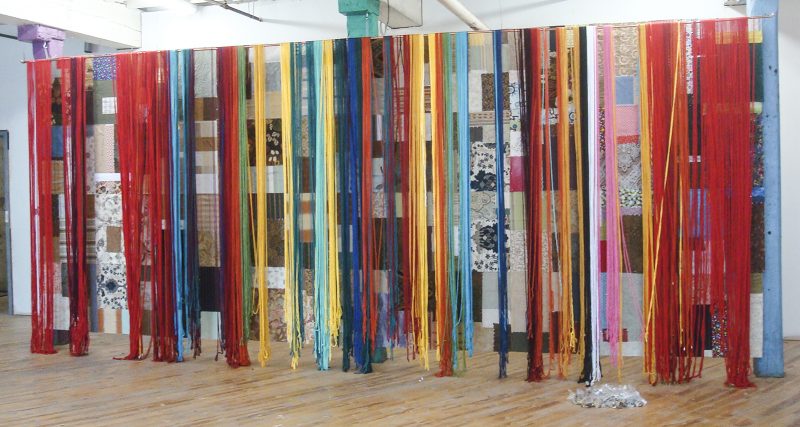
Wounds
Following a prompt from Lanre, the studio team wrote a poem about wounds, both physical and emotional. Visible or covered, everyone has them. The group wrote a collective poem and created a piece based on their writing, which are displayed side by side. Vertically hanging strings punctuated by scattered bullets provides the accompanying visual.
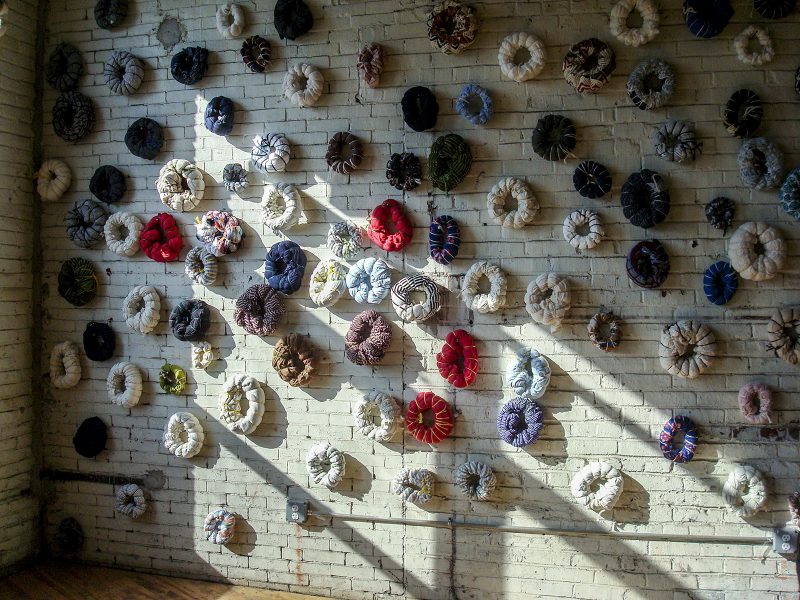
Osuka
In the installation viewers frequently refer to as the “Donuts,” the forms in question are actually osuka, cloth used to balance objects being carried on one’s head. Lanre hopes in the future to fill an entire room with them. The piece explores loss– the loss of agency, exploitation of labor, and the loss of those in the global economy not making what they need to live because the market allows them to be paid less. It discusses the complications of daily life on a global scale.
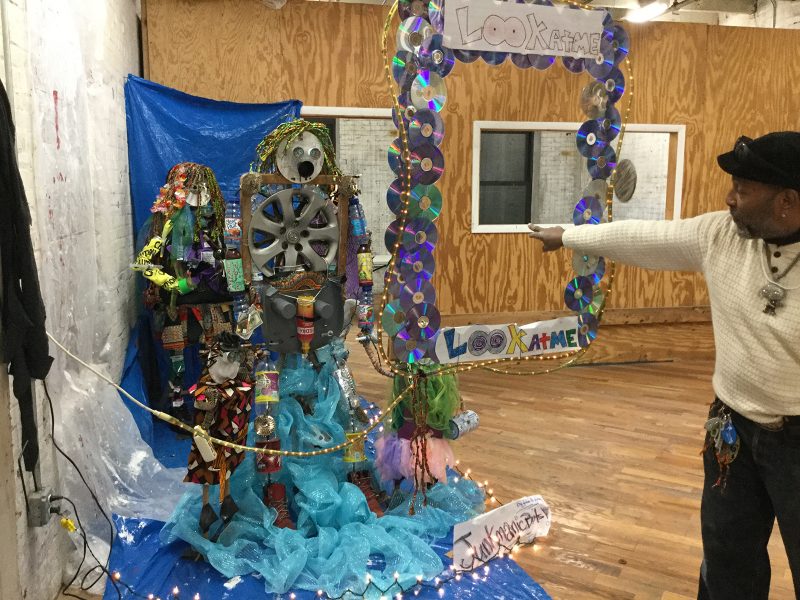
Junk Manic Robots
“Junk Manic Robots” is a “special feature” in the exhibit, community member Ruben Antonio Gutierrez’s first art piece. Throughout Lanre’s residency, studio assistants searched for people in the area who wanted to be involved. On one of their trips to a nearby office they met Antonio, who was inspired by the project and asked for some materials to work with. The next day, Antonio returned bringing the first figure in the series to the studio. Impressed, Lanre told Antonio he could be in the show if he made more.
The piece is striking, consisting of trash and fabric arranged to look like a series of robot-humans. “Junk Manic Robots” reflects his past, present, and future–from battling addiction, to his dreams of where he wants his life to go in the future, wanting children, wanting to travel and have money.
His vision is reflected in material choices. The back is his past self, represented by darker colored objects and scattered bullets, while the front represents his hope for the future using children’s toys, money, and lighter colored objects.
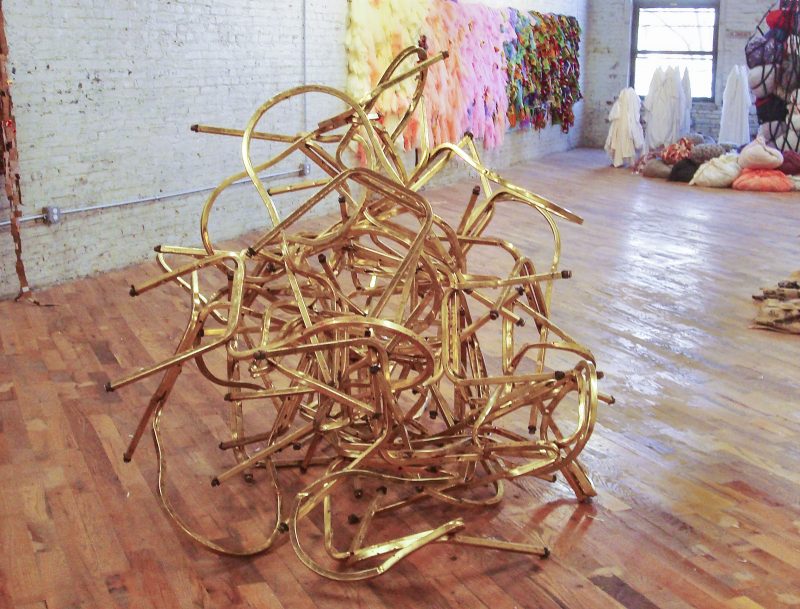
Royal Seat 1 & 2
On a trip to the recycling center, Lanre was drawn to the golden chairs used in these two sculptures. Bringing to mind royalty, the idea that “the rich also cry” was the motivation behind these two. Juxtaposing to the other experiences represented in the show, Lanre feels it’s important that everyone’s experiences are recognized.
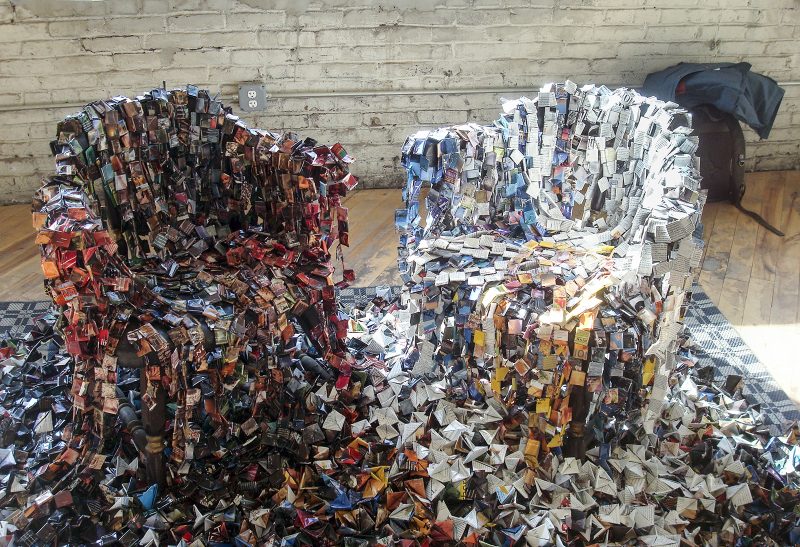
Flashback
In “Flashback,” two chairs sit facing each other as though in conversation, covered by meticulously folded magazine articles. This was another piece that resulted from finding unusual materials by chance. Finding a ridiculous quantity of National Geographic magazines in the Village office, Lanre noticed a particular page in one of the magazines titled Flashback and used that as a starting point. Later on, Lanre found two chairs and decided they went together with the flashback concept; chairs much older than he was paired with articles facing the past.
So what?
Lanre’s target audience was people that have lost a loved one violently, “wanting them to have the feeling they are not alone in the struggle.” On a larger scale, concerns of globalization, the value of labor, and the balance of production are presented for the viewer to consider. The show also obviously touches upon those concerned with the environment, raising concerns about how we can be more constructive in using our waste, finding ways to transform waste (and perhaps painful experiences) to something beautiful.
Lanre’s six-month residency ended in February and he is now back home in Abeokuta, Nigeria.
Material Memory closed at the Village of Arts and Humanities on February 7th.









